Content mostly related to tabletop RPGs, especially the Pathfinder RPG by Paizo and other games based on the d20 System
Don't wanna be here? Send us removal request.
Text
I love the concept for this feat, and it’s great to see Boomer creating some more Pathfinder First Edition material...I love all his stuff, but his PF1E and fiction pieces are still my favorites (at least until the second edition of Bloodlines and Black Magic comes out...). I’ve been supporting his Patreon for years now, and am always glad to see Patron-funded creations come out.
I also support some Patreons of visual artists, including Dean Spencer, and I love it when an RPG mechanic (or story) makes me think of a piece of art. In this case, reading the abilities granted by Weave of Shadow & Serpent-Magic reminded me of Queen of Serpents, one of Dean’s (admittedly somewhat racier) full-sized cover pieces. I’d love to put the two together for a game at some point!

Weave of Shadow & Serpent-Magic
Weave of Shadow & Serpent-Magic – Bloodlines & Black Magic / Pathfinder (1st Edition) Spellcaster Feat
You are infused with the coiling, ophidian sorcery of the twisted serpentine.
Brought to you absolutely free to enjoy, to test & to share – as always – by the fine folks of my Patreon.
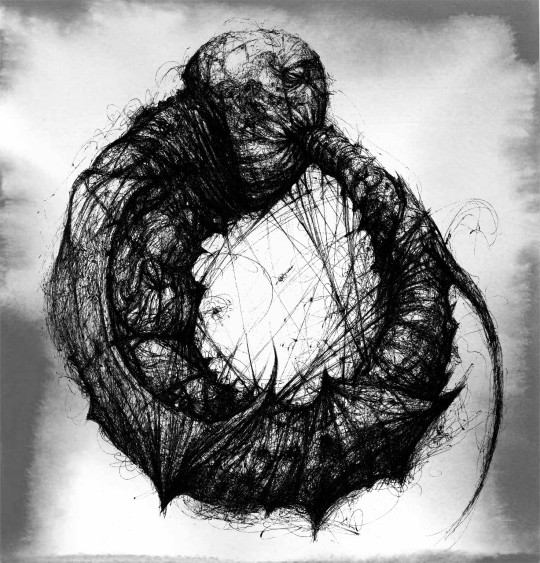
original image by Barandash Karandashich
Prerequisite: Non-good alignment; see Special, below
Benefit: You retain access to this feat only so long as you ritualistically kill at least one sentient creature each month. This ritual requires one full hour of total concentration and must occur on a specific date – chosen by you when this feat is taken – and may not be interrupted in any way in order to be properly completed. You may choose to sacrifice additional creatures at the time of the ritual, increasing the ritual’s completion time by one hour per total victim; for each additional creature ritualistically slain, you become younger by one year. You may not become younger than the starting age for your race by use of this feat.
If you ever lose access to this feat because you fail to make a proper sacrifice, you regain access as soon as you perform the proper ritual.
You add the following spells to any one spell-list you possess at the appropriate level:
1st – summon monster I (viper only)
2nd – summon monster II (1d3 vipers or venomous snake only)
3rd – beast shape I (serpent only), summon monster III (1d4+1 vipers, 1d3 venomous snakes, asp, constrictor snake or snake swarm only)
4th – beast shape II (serpent only), summon monster IV (1d4+1 venomous snakes; 1d3 asps, constrictor snakes or snake swarms; or venomous snake swarm only)
5th – beast shape III (serpent only), summon monster V (1d4+1 asps, constrictor snakes or snake swarms; 1d3 venomous snake swarms; or emperor cobra or anaconda only); quickened summon monster I (as above)
6th – beast shape VI (serpent only), summon monster VI (1d4+1 venomous snake swarms or 1d3 emperor cobras or anacondas only); quickened summon monster II (as above)
7th – summon monster VII (1d4+1 emperor cobras or anacondas; or giant anaconda only); quickened beast shape I (as above), quickened summon monster III (as above)
8th – summon monster VIII (1d3 giant anacondas only), quickened beast shape II (as above), quickened summon monster IV (as above)
9th – summon monster IX (1d4+1 giant anacondas only), quickened beast shape III (as above); quickened summon monster V (as above)
You also gain these spells as spells known, as appropriate.
You may always choose to summon serpents using a spell granted by this feat as a standard action (rather than as a full-round action, as normal); if you do so, the range of your summon monster spell drops to 0 ft.: all serpents summoned by use of this ability must appear in a square adjacent to your own: emerging from the folds of your cloak, from your shadow, from your wounds or from the blood spilled at your feet, as you desire.
In addition, as a standard action you may sacrifice a single spell of 1st level of higher to teleport (no chance of error) into any space occupied by a serpent that you have summoned. The chosen serpent automatically teleports into your former space (no save). If either you or your targeted summoned serpent cannot legally occupy your respectively-selected new space for any reason, this ability fails: both your 1st-level spell and your action are wasted.
You may always choose to sacrifice a spell of 5th level or higher to teleport in the same way as a swift action, rather than as a standard action.
If you possess 7 or more Hit Dice, once per day as a standard action you may gain the following benefits for a number of minutes equal to your Hit Dice:
You are immune to the attacks and effects of all snake swarms created by use of this ability (see below).
Any effect that grants a bonus to attack rolls, damage rolls, or skill checks against creatures of the snake or animal type (such as a bane weapon, or a ranger’s favored enemy class feature), also grants that same bonus to rolls against you.
Whenever you suffer damage from a confirmed critical hit, suffer bleed damage, suffer slashing damage or die, a snake swarm spills-forth from the injury; at least one square of this swarm must appear in a space directly adjacent to you. If you possess 13 or more Hit Dice, you instead generate venomous snake swarms.
You have no control over swarms released from your body in this way, although these swarms are considered to be summoned by you and vanish after a number of rounds equal to your Hit Dice.
You may always choose to sacrifice a spell of 4th level or higher to use this ability an additional time per day. If you possess 13 or more Hit Dice, you may gain these benefits as a swift action (rather than as a standard action) and may always choose to sacrifice a spell of 7th level or higher to use the ability an additional time per day.
As a standard action, you may expend a spell of 1st-level or higher to gain the benefits of a gaze special attack (see below) with a range of 30 feet; you retain use of this gaze for a total number of rounds equal to your character level. Any living creature who fails her Will save against your gaze (DC 10 + ½ your character level + your Intelligence, your Wisdom or your Charisma modifier, your choice) is marked.
Your gaze may only mark corporeal, living, intelligent creatures. In addition, if the subject of your gaze would not normally have lustful feelings toward you, as per the unnatural lust spell, she receives a +4 bonus on her saving throw.
Whenever you summon a serpent, you may choose for any number of creatures that you summon in this way to emerge directly from the flesh of a foe (or foes) that you have marked. Serpents summoned in this way automatically move – immediately after emerging – to occupy an unoccupied space directly adjacent to the marked foe from which they emerged.
All serpents that you summon in this way are considered to possess the Shapechanger subtype and to possess the Gruesome Shapechanger feat; being summoned by you in this way is treated as a use of change shape.
No more than one summoned creature may emerge from the body of any one marked foe when a summoning spell is cast in this way.
The marked target chosen to act as the point of origin for your summoning spell must also succeed at a Fortitude save (DC: 10 + half your caster level + your Intelligence, Wisdom or Charisma modifier, your choice) or suffer an amount of damage equal to 1d6 points of damage per spell-level of the summoning spell plus an amount of damage equal to your Intelligence, Wisdom or Charisma modifier (your choice) and be nauseated until the beginning of your next round.
A successful save halves this damage and negates the nausea effect.
Special: This feat may be gained in place of any Witch Hex.
Campaign Note: Within the Bloodlines & Black Magic setting, this ability is most common amongst witches drawn from the Shadow Bloodline in service to the Serpent of Obsidian Knives; rumors persist that members of the now-vanished Lineage known as the Eyes of Nyx (see page 61) were the truest masters of this black art, although their apprentices were legion. In addition, the Archons task each & every of their loyal servants – including such disreputable Lineages as The Masters (see page 56) – to hunt-down & execute anyone known to practice this technique, seeking to rid the world they now rule of all such dangerous Goetic intrusion.
29 notes
·
View notes
Link
Not what I usually put on my tumblr, but I’m not on social media where most people share this sort of thing (unless does tumblr count? If so, it’s the only one, and if not, it’s as close as I get). I just heard Meg Myers today for the first time today, and I believe this is the first time I’ve heard an artist younger than me and was like “hot damn, I want to go buy that CD.” I was listening and got the chills, and the strangest flashbacks to forcing my way out the Jehovah's Witnesses where my parents' had raised me. After a few songs, I went to Meg's Wikipedia page and what do I see? She was raised a JW about the same time I was. I think that does something to your psyche that other escapees connect and relate to. Kind of scary to think about, but also kind of comforting that there are folks out there who can relate, and who produce relatable music.
135 notes
·
View notes
Text
Congrats to Boomer, Jaye, and the rest of the Bloodlines and Black Magic team on a well-deserved 5-Star+Seal of Approval+nomination for Top 10 of 2018!
Bloodlines & Black Magic Review
Bloodlines & Black Magic Review
I just wanted to share this excellent review from Endzeitgeist.

image by Tim Jenkins of Battle! Studio
I post a lot about Bloodlines & Black Magic – and you can find all of my free material for the setting here – so it’s cool to hear back from the universe about what people think of the work.
As always, you can support the creation of my work here.
12 notes
·
View notes
Note
Two words: Ranged Legerdemain
I came up with a house rule for E6 rules: if you meet the prerequisites for a prestige class, you may use your bonus feats to gain class features from them even though you don't have levels in the class. Does this sound balanced to you?
Oh, hell yes!
The base Pathfinder E6 rules are intended to be simple & flexible, providing GMs and players alike with a lot of easy-to-implement options. I think your house-rule is an absolutely brilliant add-on for players who are interested in getting a few choice bits out of a Prestige class … which, let’s face it, are usually NOT particularly overpowered mechanically. :)
Thanks for writing in, and keep sending questions this direction!
10 notes
·
View notes
Text
The Way of the Gun
D&D 5E Modern homebrew feat for the City of Looking-Glass Shadows Campaign by Clinton J. Boomer. This is a derivative creation.
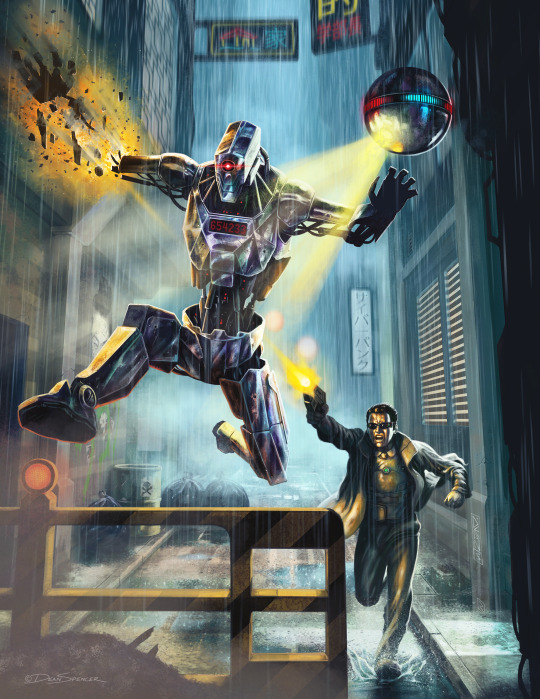
Original art by Dean Spencer, used under license. If you enjoy this and want to see more art like it, consider joining me in supporting Dean’s Patreon.
The Way of the Gun
Prerequisite: Awakened Human
Much like your inhuman associates, you are unaffected by mundane firearms (see Eleven Fun Facts about the City of Looking-Glass Shadows item #6). You take this one step further, blending guns into the veil of illusions that you pull tightly around yourself. You gain the following benefits:
You are immune to mundane guns while in the demiplane of the City of Looking-Glass Shadows, just as a sentient non-human. Any effect that would suppress this benefit for a sentient non-human also suppresses it for you.
You learn a single evocation cantrip that requires an attack roll. You may learn this cantrip from the from the sorcerer or warlock spell list, in which case Charisma is your spellcasting ability, or from the wizard spell list, in which case Intelligence is your spellcasting ability.
You may use a firearm as a spellcasting focus. If the firearm is magical and you are attuned to it, any magical bonus to the gun’s attack rolls also applies to your spell attack rolls and spell saving throw DCs.
When wielding a firearm, you may use an action to appear to shoot it at a creature. Rather than fire as normal, you cast a single evocation spell through the gun; the sound and other sensory effects are those of a gun discharging rather than a spell being cast (although a bullet is not used in this process). This evocation spell must require an attack roll or rolls; for each attack roll made (such as from multiple rays of an eldritch blast), the gun seems to discharge a separate shot.
In any round in which you fire a gun or appear to fire a gun while casting a spell, you may spend a bonus action to cast an evocation cantrip through your gun, as above.
2 notes
·
View notes
Text
I want to run this campaign if I ever get a 5E Modern game going (my d10 will probably be loaded in favor of a couple of those plot-hooks that I had a hand in creating). There are things about 5E that make it seem like it might be easier than Pathfinder to adapt to a modern setting, so as much as I love and want to run Eve of Dreams, this one has a better chance of getting off the ground. I already have an idea for a setting-specific feat or two to house-rule into the game...
City of Looking-Glass Shadows
City of Looking-Glass Shadows – an urban-fantasy D&D 5E campaign
The year is 199X.
It’s been this way for a while now.
The world is a lie. We live within an artificial construct, a facsimile of mundane reality forged upon a pocket-shard of arable land – adrift somewhere deep in the Shadowfell – built with slave labor by the illithid to house, to monitor & to control a teeming, screeching, anxious mass of hand-selected human cattle.
The goal of their project is simple: we are here to generate new technological applications. We are a living algorithm, assembled by our starry masters to the endless & perpetually-accelerating task of spitting out ever-deadlier and more brutally efficient weapons of conquest & control, engines of wealth & war, tools of mechanical intelligence & information-manipulation.
No wonder we all feel a little … stuck, huh?
The simplest, most brute-force way to produce the desired technological output at the necessary volume involved building an invisible cage and keeping several hundred million humans magically-illiterate, desperate, confused & tech-hungry.
So that’s what they built, way out here in the echoing void.
Welcome home.
A desperate, silent war for the future of this ugly, distant demiplane is being fought in the shadows, right now … and the monsters are winning.
Brought to you absolutely free to enjoy, to test & to share – as always – by the fine folks of my Patreon.
Inspired by Big Trouble in Little China, Blade, Dark City, Hackers, Heavy Metal, Highlander, They Live & Werewolf: the Apocalypse.
This website references trademarks and/or copyrights owned by Hasbro, Inc. We are expressly prohibited from charging you to use or access this content. This website is not published, endorsed, or specifically approved by Hasbro. This material is posted under the Fair Use clause of copyright law.
Created by Clinton Boomer & Uncle Twitchy.
Special thanks to Jessica Redekop of Redcap Miniatures, Blaine Bass of Scrapfinder, Landon Bellavia of Quest Writer, Neal Litherland of Improved Initiative & Sam Berry of Nomad Tattoos for being my beta-readers.

image by jim pinto
Our false universe has been invaded. Several times.
Keep reading
25 notes
·
View notes
Photo
Hey @thatboomerkid , did Old Wishtwister Shaibriri or Jiklichu Jha the Despoiler of Desires start advertising through fortune cookies? "Within the month" smells of glabrezu....
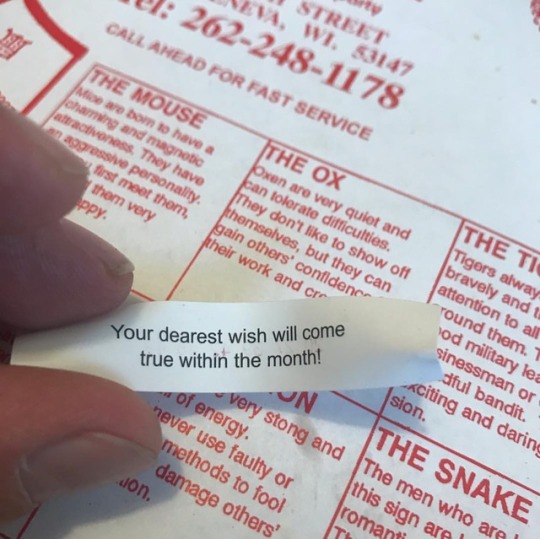
More photos from @gary.con! #BestGamingCons #GaryCon #dungeonsanddragons #dnd #gaming (at Lake Geneva, Wisconsin) https://www.instagram.com/p/BuxCLz3DupM/?utm_source=ig_tumblr_share&igshid=11xjkqq4gt14u
3 notes
·
View notes
Text
The Beckoned Clockwork Swarm
Gears & wings, cogs & stingers, millions of tiny shards of clockwork magic shimmer forth with a singular purpose: Consume and Control for the Maker.
Inspired by Beckon Forth the Clockwork Swarm by Clinton J. Boomer. Specifically, if you get to use that feat, this should, to the best of my ability, provide the stat block you need for your clockwork hellwasp swarm. If you find any errors, please leave a note or send me a message.
Clockwork Hellwasp Swarm CR 9
XP 6,400
N Diminutive construct (clockwork, swarm)
Init +12; Senses darkvision 60 ft., low-light vision; Perception +0
DEFENSE
AC 29, touch 23, flat-footed 20 (+8 Dex, +1 dodge, +6 natural, +4 size)
hp 66 (12d10)
Fort +4, Ref +14, Will +4
DR 15/adamantine; Immune construct traits, swarm traits, weapon damage; Resist acid 10, cold 10, fire 10, sonic 10
Weaknesses metal body, vulnerability to electricity
OFFENSE
Speed 5 ft., fly 40 ft. (good)
Melee swarm (3d6 plus distraction and poison)
Space 10 ft.; Reach 0 ft.
Special Attacks distraction (DC 16), inhabit
STATISTICS
Str 5, Dex 26, Con –, Int –, Wis 11, Cha 3
Base Atk +12; CMB +16; CMD 23 (can’t be tripped)
Feats DodgeB, Improved InitiativeB, Lightning ReflexesB
Skills Craft (clockwork) +5, Disable Device +5, Fly +18, Stealth +15; Racial Modifiers +5 Craft (clockwork), +5 Disable Device, -5 Stealth
SQ created mind, creator bond
SPECIAL ABILITIES
Created Mind (Ex) A clockwork creature only accepts commands from its creator or designated surrogate. A surrogate can be designated by the creator for any length of time and be rescinded by the clockwork’s creator.
Creator Bond (Ex) A clockwork creature can instinctively detect the location of its creator within 100 ft., regardless of magical and natural barriers. Within this range the clockwork gains a +10 circumstance bonus vs. Bluff checks, Disguise checks and any other effect made to impersonate the clockwork’s creator.
Inhabit (Ex) A hellwasp swarm can enter the body of a helpless or dead creature by crawling into its mouth and other orifices. Inhabiting a body requires 1 minute, and the victim must be Small, Medium, or Large. The swarm can abandon the body at any time as a full-round action. Any attack against the host deals half damage to the hellwasp swarm as well, although the swarm’s DR, resistances, and immunities may negate some or all of this damage. When a hellwasp swarm inhabits a dead body, it effectively transforms the corpse into a zombie of the appropriate size under the swarm’s control. If a hellwasp swarm inhabits a living victim, it can neutralize the effects of its own poison and control the victim’s movement and actions as if using dominate monster. (Note: if summoned via Beckon Forth the Clockwork Swarm, the swarm’s master has direct control of a creature thus dominated.) Hellwasps quickly consume a living victim, dealing 2d4 points of Constitution damage per hour.
A hellwasp-inhabited creature is easy to spot, since its skin crawls with the forms of the insects inside. A swarm can attempt a Disguise check to conceal its inhabitation of a host, with a -4 penalty if currently inhabiting a Small host.
A remove disease or heal spell cast on an inhabited victim forces the hellwasp swarm to abandon its host.
Metal Body (Ex) A clockwork creature is largely composed of metal. It counts as a ferrous creature for the purpose of rusting grasp and other spells that have special effects on metal.
Poison (Ex) Swarm—injury; save Fort DC 16; frequency 1/round for 6 rounds; effect 1d6 Dexterity damage; cure 2 consecutive saves.
#Pathfinder#Monster#Inspired by That Boomer Kid#Clockwork#Hellwasp#Swarm#Beckon Forth the Clockwork Swarm
13 notes
·
View notes
Text
I remember reading the first few chapters of this somewhere online a few years ago, but lost the link. I never found chapters 5 or 6, nor whether Old Wishtwister Shadibriri managed to get that tome into the hands of the governor. My life feels somewhat more complete now.
Battle-Banners of Lesser West Podunk
Battle-Banners of Lesser West Podunk
Pathfinder Fiction by Clinton J. Boomer
Brought to you absolutely free to enjoy, to test & to share – as always – by the fine folks of my Patreon.
Chapter One: Blood and Giggles
Old Wishtwister Shadibriri was having himself another truly lovely day.
It was a morning of smoke and screams and sweat and sobs, a morning of the dead and the damned and the doomed and the dying, a morning echoing with the clash of steel on wet-painted wood and the shrieks of tattooed flesh torn to ribbons by betrayers’-blades. The woods were filled with young men chasing after hot, red glory; with old men weeping over festering, ancient grudges and ugly new wounds; and with fresh-made corpses growing fly-blown in the damp heat of a hazy summer dawn.
It was a morning filled, in short, with delight, reward … and opportunity.
As he strode down the muddy, bloody and night-soiled path between the warring camps, steam rising ‘round his priestly-garbed glamer, the ageless demon called the Wishtwister began to fairly skip and sang out jubilantly with the little girl who pranced beside him:
“One and two! Black and blue!” “Three and four! Gone to war!” “Five and six! Bones and sticks!” “Seven! Seven! Gone to heaven!” “Eight! Eight! Burn the gate!” “Nine and ten, and ten-and-ten! 'Round and 'round and 'round again!”
“HAI!”
With a shriek, both of them spun in place and jumped once. Then the girl gleefully dropped a glass vial over her shoulder. It landed in the middle of the trail with a dull plop.
The pair stopped and stooped for a moment to consider the tiny prize: a crystalline, bluish hue suffused through the liquid within caught the sunlight, dim like a candle. The Wishtwister idly calculated its value at somewhere equal to the pay of nine years’ honest, back-breaking labor by any single member of the little girl’s family - perhaps, in fact, the very age of the child herself.
Shadibriri had not yet asked how old she was. Or her name, for that matter.
His little assistant looked to him. “What’s inside it, Bishop, sir?”
“Eh? Oh. Magic.”
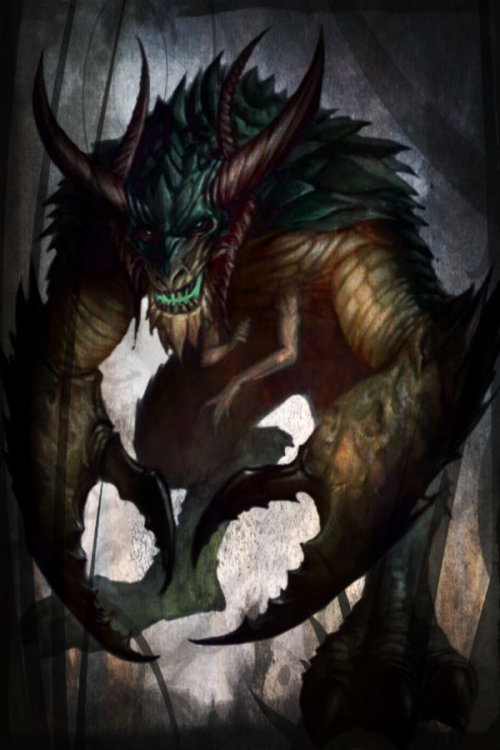
The Wishtwister’s attention was drawn then, for an instant, by another bit of mischief: some hundred yards back up the road, a wounded young man of perhaps fifteen summers staggered from the tree line toward a similar prize sparkling in the shifting shadows, only to be cut down a mere hair’s-breadth from his salvation by arrow-fire from some unseen sniper.
The demon chuckled.
“What magic?”
“Hmm-what? There? Distilled inside, a potion of aiding, for the shrugging off of wounds! It will make a man brave, and his arm strong; his fear will shrink to a tiny thing, far in the distance, and his pain will be forgotten. Even a fellow sunk deep upon his deathbed might spring to his feet with a drop of this, and fight like a bear in heat with it sparkling on his tongue.”
“A medicine, Bishop?”
“Oh, no, no-no. It is a potent mystical compulsion of the mind only, and quite temporary - lasting merest moments.”
The girl nodded, and reached unbidden into the clanking leather-bound satchel which hung from the Wishtwister’s arm. She pulled forth another vial.
“And in this one?”
“Whiskey, mixed with a kiss of cherry-juice. Very similar stuff, though vastly cheaper.”
She tugged forth another from the seemingly endless contents of the bag, and he smiled with delighted pleasure at her rude presumption. This little lass was a wicked girl, careless and curious and more than a little selfish – as children so often are.
“And this?”
“That? Ah, poison - and most dreadfully painful.”
The girl gasped, and then a sly smile spread across her face.
The Wishtwister did not bother to hide his grin at her reaction. This girl was cruel, and as capricious as he. “Ah, indeed! My thoughts exactly, and such fun! But before we set it down for someone to find, let us walk another few paces, shall we? Oh, for-a … One and two, black and blue!”
“Three and four! Gone to war!”
And away the kindred spirits danced.
Their merry, nonsense song carried far before them along the path as the two wove further into the woods, wracked as it was with other, more brutal sounds this morrow - of struggle, and suffering, and sorrow.
Yes, it was a deeply fine day to be walking to and fro on the earth.
Chapter Two: Last Night’s Laughs
The evening before had been less auspicious, of course, but there had been some mad and giggling promise in the storm clouds hunkered above as the Wishtwister, dressed as a cleric, arrived at the little town he had come to name “Lesser West Podunk.” The old fiend had learned to trust those little auguries and omens, even as the ages which had taught him those instincts slowly faded into a confusion of sharp fractures and slick half-memories.
His traveling companion last eve, the wandering, west-born sell-sword called Durnaur of the Legion-Serpent, had of course repeated the name of the town several times along the way, but since it was little more than a wide clearing where a few dirt roads met in the sparse wood, and a good nine days’ travel from anything approaching actual civilization, Wishtwister Shadibriri had staunchly refused to memorize it.
Keep reading
9 notes
·
View notes
Text
This is by far my favorite Pathfinder Modern setting for blending elements of standard PF with the "real" world (pantheon, Tarrasque mythos, etc.).
Eve of Dreams & the AWAKE
Eve of Dreams & the AWAKE: a Pathfinder Modern urban fantasy mini-setting for the E6 rule-set, for especial use with the Auspices of the Armageddon Engine and Loyalty campaign sub-systems.
All setting-specific content on this blog is tagged: Witch Hunter.
Brought to you absolutely free to play, to test & to share, as always, by the fine folks of my Patreon.

The gods are distant, their strange prophets cloaked in secrecy & shadow. Hidden behind closed doors, ancient rites and layers of black lies, even the most subtle of magics are practiced only by the insane and the obsessed; guns and money openly rule the streets, while clever magicians of all stripes walk in the half-light that narrow path between two extremes: an abject terror at the risk of discovery, matched against an overwhelming temptation to capitalize upon a dark monopoly over life, death, madness, power & reality itself.
Yet the bizarre gifts of sorcery are growing strong & thick once again as the Rough Beast‘s Herald stirs in its deathless slumber. Paranoid and desperate mortals grow more numerous still, possessing sharper eyes, keener blades and hotter pyre-flames than ever before.
Each night, the secrets of an unspoken & unseen witch-war come closer to their final revelation; a dark & smoke-filled dawn is coming … and with it shall come screams.
Welcome to the moment before the Masquerade fails.

SETTING RULES:
– This campaign uses the Guns Everywhere rules: firearms are simple weapons; the gunslinger loses the gunsmith class feature and instead gains the gun training class feature at 1st level. If a character has the simple weapon proficiency and would also receive firearm proficiency as a class feature – such as from the Cityskin Warlock or Roar of Rovagug class archetype – she instead gains weapon training with one firearm of her choice.
– All PCs – but not NPCs – gain a high-octane, action-hero dodge bonus to AC equal to their class level as long as they are not wearing armor. This bonus increases by one for each form of armor proficiency (light, medium, heavy, shields, tower shields) the character possesses, either from class features or the expenditure of feats. – Ability score-sets are generated by d100.
– Human is the default race, and the only of the Core Races available for play; this setting does not support dwarf, elf, gnome, half-elf, half-orc or halfling characters, as no playable non-human families or organized societies persist to the present day.

– With the GM’s permission, a PC may choose to play as an aasimar, tiefling, ifrit, oread, sylph, suli or undine; such creatures are beyond rare in the extreme, and a PC of such a race would more-than-likely be the only creature of their own kind known to them, born to two seemingly-human parents and beginning to exhibit strange powers only at puberty. The arrival of such creatures amongst humanity once more is said to be a sign of the end-times; fortunately, such characters may freely pass for human when not fully manifesting their gifts.
– Magic is much more difficult to master; to learn, prepare, or cast a spell, a magic-user must possess a relevant ability score equal to at least 15 + the spell level. Thus, a wizard needs an Intelligence score of 16 or higher to cast 1st level spells and a warpriest requires a Wisdom score of 17 or higher to cast 2nd level spells. Only the most brilliant, talented and focused of individuals – perhaps one in a billion – can learn to channel the raw occult energies which are required for the use of true 4th level spells.
NOTE: For every seven omens that you remove from the list, the limitation above decreases by 1, to a minimum of 10 + spell-level.
In addition, there is a cumulative 1% chance that an omen activates each week – somewhere in the world, randomly selected – once the campaign begins, as rumors fly and terror spreads.
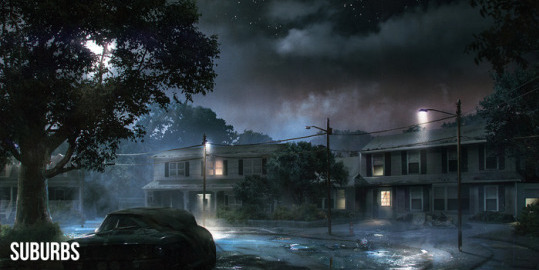
– It is a world of Subtle Spell-Casting; any creature with spell-casting abilities may double both the casting time and the Concentration check DC of any spell she casts – as she casts it – to hide the use of her abilities, usually intoning her verbal components beneath her breath and tracing her somatic components up her sleeves or in shadow. Although this does not increase the DC to identify the spell with Spellcraft check – as this technique is commonly known amongst casters – those characters uninitiated in the mystic arts will not tend to recognize that a caster practicing her art in this way is using magic: a caster both taking her time and focusing in this way may freely use a Bluff check with a +5 bonus against the Sense Motive of any mundane observer to convince them that she was just muttering and fidgeting.
Like a crazy person.
NOTE: This subtlety of spell-casting does not hide the effects of a spell, just the casting thereof.
Wanna walk into a crowded high-end nightclub or a seedy, wrong-side-of-the tracks dive-bar and throw up a quick detect magic? You know, just to see if your contacts from the Sisterhood of the Torn Veil are here, or to spot if those boys from Union Global Confederated are packing anything gun-shaped that glows with jittering gore-streaks of flesh-colored necromancy under those trench-coats?
Take two rounds to cast, old friend, and neither the bouncer nor the folks in line behind you will even notice.
Wanna drop a cure light wounds on that poor bus-crash victim?
Um, yeah. Better hope no one has a camera-phone out.

– This seemingly-mundane world is effectively “cut-off” from the greater multiverse; the only known way for mortals to achieve a true breaching of planar boundaries, at this time, is through the use of powerful Incantations and Rituals involving great risk and dozens of spell-casters.
NOTE: For more on this spell-type within Pathfinder, see Incantations from the Other Side: Spirit Magic from Zombie Sky Press and Occultic Singularity.
All other means of transcending those invisible walls between worlds are controlled by but a pair of individuals: one is a shaitan swordsman by the name of Qum Aziil, an obsessive hunter of the undead who serves as the major liaison between the Cult of the All-Seeing Eye and the Cult of the Lady of Graves.
He’s a little cranky and … unavailable.
The other is a potent glabrezu – allied with the Cult of Grandmother Nightmare and the Cult of the Savored Sting – called Jiklichu Jha, Despoiler of Desires, He who Corrupts the Coveted; he is quite likely the most powerful magic-user on the planet, and struggles nightly against a geas which binds him to both obey and to enforce the Law of the Arcanotheign (see below).
He, personally, would be more than happy to open the gates to other realms just to let in some fresh air and see a few old friends, but he’s not technically allowed to at this time.
But he’d love to grab a beer with you anyway.
– For this reason, members of the Secret Royalty need not physically pass behind the Curtain into the Nether in order to claim an Emptied Empire or a Throne; instead, most such mages are only dimly aware of their Kingdoms, glimpsed in bizarre dreams vented to our reality through the First World or the Maelstrom, claiming bizarre titles of nobility such as the Prince of Axis and Sultan of the Brass City.
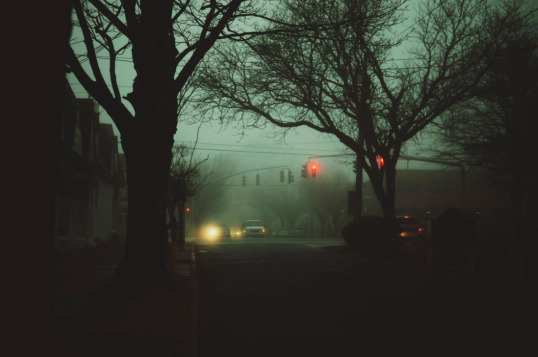
– It’s a world without paladins.
As a grey-&-black-morality, urban-fantasy/magical-noir action-horror setting on the more grim end of the sliding scale of idealism vs. cynicism, Eve of Dreams & the AWAKE does not support the inclusion of such forthright and fervent, shining and stalwart heroes.
However, it’s a perfect setting for antipaladins like the Wild Star of Fortune, the Ravener of the Burning Hand, the Sworn Blade in Darkness and the Red Knight of the Vault, especially using the Swift Executioner of Fools archetype. Of course, the Cult of the World-Breaker claims at least one Iron Warblade of Shattering Chains amongst their ranks.
For much more on alignment & setting, see this essay.
Note that the Grey Paladin, in certain special cases, might be appropriate for the setting.
– It’s a world without dragons … at the moment.
Sure: the toughest human being on the planet has 6 hit dice, the most powerful spells available to mortals cap-out at about 4th level and the greatest, most-ancient beings around are all in the CR 9-13 range.
But that doesn’t mean that the true dragons are all dead.
Far from it, actually … and when they wake up, the world is going to change drastically.
The sole active dragon at this time – a beast called Marduk the Viridian who awoke in California in the mid-90s, currently living in a beach-side mansion and making millions running internet scams from his heavily-wooded hunting-grounds – claims that he is but the smallest and youngest of seven dragons still alive: one each of the five chromatic breeds, along with a single gold and one silver.

He claims that he has lived for over 3,800 years, but has spent less than 1/20th of that awake. He claims that he has approximately one million living descendants, most of them unaware of the lineage they carry. He even claims that the dark elves are not extinct, but have instead built great, black-marble pyramids in shadows far beneath the earth.
And, moreover, he claims that his ‘siblings’ will soon arise to feed and to rule, which has earned him a small army of devoted followers.
The raw power & knowledge which balance upon the tips of Marduk’s terrible claws – along with his continued public obedience to the Law of the Arcanotheign – have made him a very valuable asset, continuously courted by influential members of every Cult.
Of course, he could very well be lying. About almost everything, actually.
NOTE: If you want to run a campaign that’s heavy on dragons, this is your “in”; have another of the seven – determined randomly – wake up every time the ability-score requirements for spell-casting are lowered by one, until all seven are awake.
Unless they can be counted-on to remain discreet, for whatever reason, it can be assumed that a week later they’re are stomping Tokyo flat; if you go this route, be sure to prep stats for Apaches, B-2s and Tomcats – for when humans fight back – and decide how you want to handle the rules for full nuclear bombardment.
Needless to say, such a drastic departure from either traditional high-arcane, dungeon-crawling heroic adventure or classic urban fantasy is far beyond the scope of this mini-setting.
If you want to keep the game low-powered, though, Marduk is totally bluffing; he has no idea where the other dragons are.
– “A person is smart. People are dumb, panicky dangerous animals and you know it.” Groups of mundanes react poorly to the revelation of magic; casting lethal spells in front of a crowd is a good way to get yourself and everyone around you killed.
See the Fear of Magic sidebar below for details.

Cults: Each character with PC class levels chooses a starting Cult from one of the following seven choices; she receives the listed bonus from her affiliation as long as she is wearing the iconic colors of her Cult.
A PC adds +2 to starting Loyalty for a fellow PC who shares her Cult.
Keep reading
28 notes
·
View notes
Note
I played around with Most Faithful of Her Legions for another hour after sending in the question above. Now that I have confirmation that it’s the final stage of character advancement before leveling that gets summoned, I will play around with adding in Recall From Endless Void.
My brain likes to go back and forth between statting out characters with feats like this, and taking characters with these feats and inserting them into stories (almost like fast-paced solo diceless campaigns, painted in broad, sweeping strokes where flavorful abilities like this provide the color palette).
Anyway, after some character simulations, I have two thoughts on Most Faithful of Her Legions (aside from the initial “This F***ing Rocks!”).
First off, the feat says “your ward adds the following options at the appropriate levels to all of her summon monster lists:
2nd level: a copy of you as 1st level character
3rd level: a copy of you as a 3rd level character
7th level: a copy of you as a 7th level character
9th level: a copy of you as a 13th level character”
My thought on this is that the 7th level copy of the witchguard should be summon-able with summon monster VI rather than smVII. The reason for this opinion is two-fold. First, a 7th level witchguard is CR 6, which is more in line with the summons from smVI than smVII. Second, this allows every level of summon monster to have a unique subject. The original version means there is no difference in the summons by smV and smVI (both 1d4+1 copies of the 3rd level witchguard). This is just my opinion here, and Boomer probably has reasons I didn’t think of for assigning the levels as he did, but that’s my 2cp for anyone using this feat in their game.
My second big take-away is that this ability is super-potent with Blood-Linked Defender. I haven’t run all the numbers at multiple levels to form an opinion on the overall balance, but I might be wary before bringing that combo into my game. Of course, thematically, I’m sure this is exactly the intent of the feat: bring in expendable, willing-to-die-for-The-One copies of the witchguard with cool abilities to boost Her power and protect Her. But mechanically, a 7th level witch using summon monster IV to create (on a good d3 roll) three 3rd level copies of the witchguard suddenly goes from 34 hp (for a non-optimized standard NPC witch) to an effective 34 + 3 x 27 = 115 hp. That bonus 81 hp is enough to soak an average CL 11 disintegrate spell (77 damage) without even dropping any of the summons to 0 hp. It gives enough of a buffer that, if the actual witchguard is around to soak some damage as well, the witch could in theory survive a destruction spell. Is this level of enhanced defense unbalancing? I’m not sure. Was Most Faithful of Her Legions designed with Blood-Linked Defender in mind? Not sure again (though I’d love to know! Maybe Boomer will give a little insight into his design process here?). Do I really really really want to see this combo in action in a game, rather than just on my scratch papers, so I can see how it plays out? You bet!
Most-Faithful of Her Legions is an awesome feat. Do you have any advice for determining what equipment shows up with a summoned copy of a character? E.g. let's say I have a potion of cure light wounds at character creation, and just before I level up to 2, I have potions of invisibility and bull's strength. What potions does my summoned 1st level version have? And as a side note, considering how this feat could work with Chronothurge Adept and Recall From Endless Void gives me convoluted joy...
Huzzah! I’m quite proud of Most-Faithful of Her Legions (and of all my Witchguard material!), so I’m very glad you dig it.
Of course, I’m also a huge fan of your work, especially the Aristocrat Vampire that I can’t seem to stop linking-to. :)
As to what gear, precisely, appears on each of your “earlier-level” copies: in theory, this is the sort of thing that your GM should help you sort-out. Both of you need to agree, after all – and 1000%! – on the veracity of your final sheet.
My initial thought is that the sheet you should copy is the LAST one, just before you level, right before your PC gets the experience-bump (and treasure-bump!) to take him or her into the next section of the campaign. Whatever gear you’re holding onto at that time is, in theory, iconic to “who you were”.
So yeah, you might have a few potions on you. Drinking them takes time, of course, especially during those only-a-couple-seconds-long existences as a summoned creature … so I don’t see it being problematic or unbalancing. :)
Hope this helps, and thanks for writing in! And if you play around with this more, LET ME KNOW!
11 notes
·
View notes
Photo
Well, what do you know? One of the random Tumblr recommended blogs that showed up on my dash turned out to be an actual artist and not just a high-volume-reblog meme page. She did some great Inktober work (summary here, full pictures on the blog) and has some cool original and fan art pieces. Maybe reblogging something from this page will train the tumblrbots to direct more original art into my feed? One can hope.
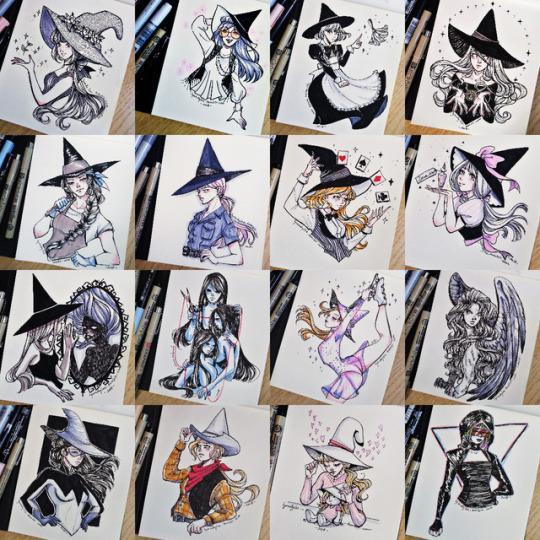

I had fun with this year’s prompt for inktober. Although it took me a while to finish it, the important thing is I made it 😬 I hope you guys enjoyed my witches and I want to say “HELLO!” to my new followers! 😘
KISS KISS FALL IN LOVE!
#Inktober#inktober2018#lynndylee#artists on tumblr#artwork#art#illustration#drawing#witchcraft#witch
214 notes
·
View notes
Text
Proud Papa Gamer
I just need to take a moment to share my joy about my gamertastic kids, especially my third. If you don’t like hearing dads brag about their kids, stop reading now. Seriously, you have been warned.
Still reading? OK, cool. Here goes.
Almost two years ago (Feb ‘17), I started running a Pathfinder game for my wife and three oldest kids (all girls; I have a son, now age 3, and youngest daughter, now age 1, who are too young to play). Over the last 21 months, they have climbed from first level up to (as of last night) 7th level. The youngest in the party had just turned 5 when we started, so I helped her build a super-simple but effective archer named Florda. In the beginning, she was very enthusiastic, but still had trouble adding up her attack roll (6 + the number on the die with lots of little triangles) or recognizing words on her (heavily customized) character sheet. Since she was so young, my wife and I helped her a bunch, just glad to see her engaging and not giving up.
Fast forward almost two years, with my youngest player now almost 7 years old. The party has saved the menfolk of their village from a goblin trap, saved their village from being sacrificed to a barghest, and saved a unicorn’s forest from bugbears, all with the background setting of a post-zombie-apocalypse world where zombies and lenguapedes are a constant menace. (Yes, I realize this is perhaps somewhat darker than many parents would be comfortable letting their youngsters play, but the girls voted for this world unanimously over a “My-Little-Pony” style game. I keep the game more cartoony than I would with an adult group in the same setting. We keep in touch with the clinical counselor helping two of the them with issues like ADHD and Asperger’s, and she generally shakes her head confusedly and says it seems like the game is a positive, empowering, family-building experience despite the subject matter. We dance to the wild and crazy beat of our own family drum, but we DO dance carefully.)
The party was traveling from their village to the regional capitol and last-known major human settlement (population >10,000) on the continent. They entered a fortified village guarding a bridge that they needed to cross, only to find that the village was dominated by an ego-maniacal vampire bent on becoming king (or, as he saw it, expanding his kingdom). The vampire himself was an aristocrat, a leveled up version of my Basic Pathfinder Vampire that I posted here last year. Dracula or Strahd he wasn’t, but he was plenty tough to give them a run for their money on our family Halloween game night. His “Damage Reduction 10/magic and silver” was particularly troublesome. My youngest player (who’s character “Florda the Archer” was averaging 40-50 damage per round in the last fight) could barely scratch him. She was doing anywhere from 8-15 damage per arrow, with two arrows from Many Shot, one from Rapid Shot, and one from her high-BAB iterative attack. DR 10 hit each of them so that she was doing very little net damage. It took twelve rounds for the party to finally drop the vampire, during which my wife and our second-oldest daughter almost lost their characters to negative levels, and my oldest daughter’s gnome was dominated (thankfully, my second-oldest’s witch had prepared dispel magic and was able to free her). It was brutal, and through most of the encounter, although she didn’t have much trouble hitting, Florda barely did any damage.
Well, this was the Halloween boss-fight that pretty much leveled them up to 7th level. Yesterday, we had a wrap-up session where the guards that came to save the “king” tried to keep the party from getting to his coffin to finish him off. Four 1st-level warriors against a 7th level party didn’t stand a chance, even drained as the party was (and even considering that one of the guards got in a critical hit against the witch). After the guards had been subdued (mostly by charming them to counter/interfere with the dominate effect, though one of the guards did get knocked unconscious) and the vampire had been anointed with holy water to keep him from regenerating, the party started going around town and figuring out who he had been and how this all fit into the overarching plot. They’ll need a couple days of downtime to heal up and re-build the bridge before moving on, and in that time, the characters will level up. Yesterday evening after the game and much of today was spent with the girls talking about leveling up their characters and what they wanted to get at 7th level.
After a somewhat disappointing boss fight, my youngest player wanted a way to make Florda better against monsters with damage reduction, and asked about using her feat for something that would help. Now, I still had my “simple character for a young player” mindset going. Silly Daddy. I said something to the effect of “well there is a feat called Clustered Shots that lets you add all your damage together before the monster gets its damage reduction, but it might be kind of tricky to use” and she asked to see it. I looked it up on my iPad and handed it to her. She read the full text of Clustered Shots word-perfect. I was floored. Then she asked if that would have let her do 30 more damage against the vampire. Yes, it essentially would have...four arrows, each losing 10 damage off the top to DR, combined into one blast that only lost 10 points off the summed damage, would essentially equate to +30 damage. Maybe a little less if the die rolls were low, but yeah, about 30 points. Holy crap. My six year old has it.
So, suffice to say, we spent some time talking about not-so-simple character options, and she has convinced me to give her a Stamina Pool for doing Combat Tricks as per an “Unchained Fighter.” Because, you know, fighters are great first characters, but they can get a little boring when one of her sisters is throwing around hexes and beating things with her hair, and her other sister is spending luck points (archaeologist bard) and turning invisible.
Not even two years, y’all. And she’s not even seven.
I wasn’t even supposed to be here this weekend. I had reservations to go to U-Con Gaming Convention in Ann Arbor, but our van broke down and I had to cancel last-minute (fortunately just in time to not get charged for anything) to keep the truck in town. I hate missing my favorite semi-local con, but I still got to have a weekend full of gaming and talking about gaming and generally having good times, and this was a weekend that I’ll remember for a long time, that’s for sure.
To wrap things up, I just need to add that all this was mostly going on yesterday. But, to top it all off, I was sorting through yesterday’s mail tonight. I saw a letter from the schools and opened it up. My youngest player’s teacher has referred her for testing for the gifted program. I wonder how much this game has been an educational experience without even planning for it to be. I’d be curious to find out.
If you’ve read this far, thanks for indulging me. Happy Gaming to You and Yours!
2 notes
·
View notes
Text
D&D...
As children, we have so much time that we develop hobbies to pass it, and later on, we struggle to find time for the same hobbies.
921 notes
·
View notes
Text
Baby Shark doo doo doo doo doo doo
Baby Shark doo doo doo doo doo doo
Baby Shark doo doo doo doo doo doo
Baby Shark!
Mommy Shark doo doo doo doo doo doo
Mommy Shark doo doo doo doo doo doo
Mommy Shark doo doo doo doo doo doo
Mommy Shark!
Daddy Shark doo doo doo doo doo doo
Daddy Shark doo doo doo doo doo doo
Daddy Shark doo doo doo doo doo doo
Daddy Shark!
I WILL GET YOU BOOMER!!! I don’t know when, or how, or with what shark, but I will get you for this one day, mark my drowning words!
Oh, and I love this.
Symphony of the Sharks
Symphony of the Sharks – Pathfinder Terrible Bard Feat
Doo Doo Doo Doo Doo Doo.
Brought to you absolutely free to enjoy, to test & to share – as always – by the fine folks of my Patreon.
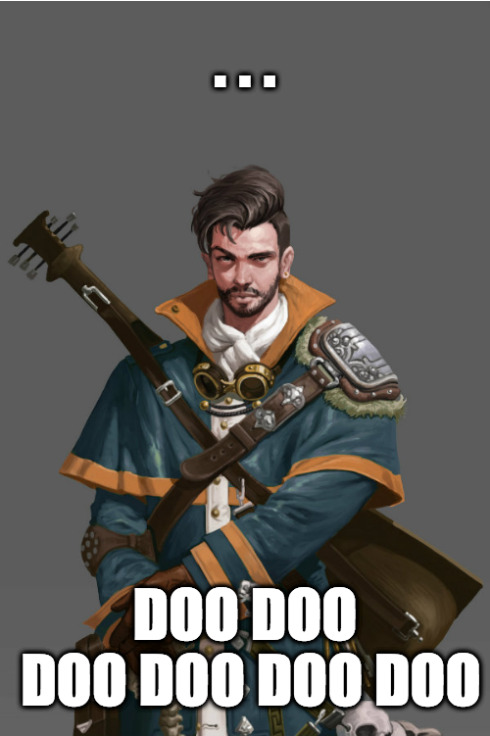
more Seduction Bard material can be found here
Prerequisite: Bard with access to summon monster spells; non-Lawful and non-good alignment (both in-character & out-of-character); character level 7th
Benefit: You add a Young Airborne Shark as a 3rd-level option to your summon monster list. Thus, you may summon 1d4+1 such Medium-sized flying sharks via summon monster V.
At will as a full-round action (but see The Song, below), you may cause any one Medium-sized flying shark that you have summoned to vanish; when you do so, you automatically summon an Airborne Shark (without the Young Simple template); this creature must appear in a square that was immediately vacated by your now-vanished Medium flying shark. Similarly, at will as a full-round action (but, again, see The Song below), you may cause any one Large-sized flying shark that you have summoned to vanish; when you do so, you automatically summon an Airborne Shark with the Giant Simple Template; this creature must appear in a square that was immediately vacated by your now-vanished Large flying shark.
Out of character, you must have ready access to a fully-built version of each of these stat-block, approved by your GM, before you may use this ability … and may God have mercy on your soul.
The Song: You may always choose to expend a single daily round of your bardic performance to either cast this special use of summon monster as a standard action (rather than as a full-round action) or to replace your shark with a larger shark as a standard action rather than as a full-round action. To do so, you must sing the song … and state, very specifically, exactly what kind of shark you are now summoning.
Designer’s Note: This is, honestly, just the worst. And I’m so sorry.
24 notes
·
View notes
Text
Arcanarunologist
Arcanarunologist, Pathfinder Wizard Archetype
The strange, toad-like aberrations known as arcanarunas claim that “their sole motivation is to catalogue all the world’s arcane magic.” Typically tracked back along a path of dead or dying worlds, these alien scholars are often blamed for directly or indirectly causing the destruction of the worlds where they study. However, few creatures in the universe can match an arcanaruna’s aptitude for gathering, unraveling, and internalizing spells. This unique talent is often sought by other practitioners of the magical arts, with spellcasters from many schools of study taking on juvenile arcanarunas as familiars. The arcanarunologist takes this path of inquiry one step farther, bonding with an arcanaruna familiar in a magical symbiosis that leads both beings to spellcasting heights that neither could reach alone.
This archetype is based on RPG SuperstarTM Mike Welham’s imagination-catching arcanaruna, created for the “Frogtober” creative challenge. He was joined in his Frogtober endeavors by artist Hugo Solis. Full credit for the fantastic monster stats and art go to the creators. This archetype is a derivative work and makes no claim of endorsement by either individual. If you like Mike’s monsters on his Frightful Fridays feature, consider joining me in supporting his Patreon. This archetype is freely available for playtesting and general use; please leave any feedback in the comments, or message me.
Section 15: Copyright Notice
Advanced Player’s Guide. © 2010, Paizo Publishing, LLC; Author: Jason Bulmahn.
Frightful Fridays. © 2018, Mythopoeic Rambling; Author: Mike Welham.
RPG Superstar is a trademark of Paizo, Inc.
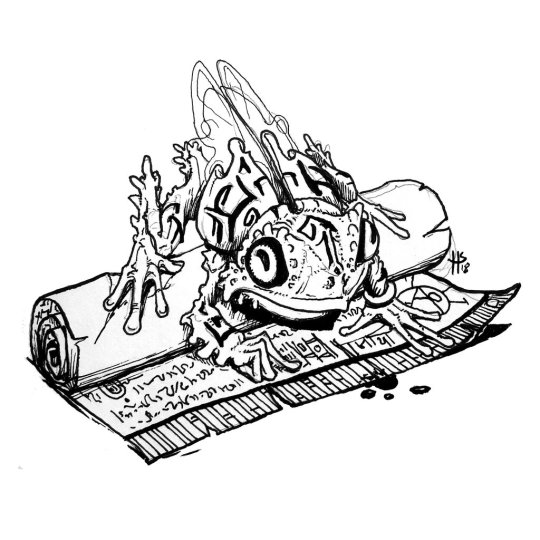
“Arcanaruna” (c) 2018 Hugo Solis, used with permission
Class Skills
An arcanarunologist adds Heal to his list of class skills, and removes Appraise.
Arcanaruna Familiar (Ex)
An arcanarunologist forms a bond with a juvenile arcanaruna, which serves as his familiar. Unlike most wizards, the arcanarunologist does not store spells in a spellbook; his spells are cataloged and stored by his arcanaruna familiar, just as a witch’s familiar stores her spells. An arcanaruna familiar cannot learn spells from a witch’s familiar through the “familiar teaching familiar” method, although they can learn spells from other arcanarunologist’s familiars via this method. They also cannot learn spells by studying another wizard’s spellbook, although they can learn spells on the sorcerer/wizard spell list from scrolls (which consumes the scroll, as usual). Additionally, the arcanaruna can learn non-sorcerer/wizard spells by extracting them from other creatures (see Spell Extraction below).
The arcanarunologist prepares his spells by communing with his familiar, just as a witch does. Until the arcanarunologist gains Improved Familiar and a corresponding arcane caster level of 7, the arcanaruna cannot impart its spell resistance or energy resistance to the wizard. The arcanaruna familiar has an Intelligence score 5 higher than a standard wizard’s familiar, but has a natural armor adjustment one point lower than a standard familiar (e.g. at 1st level, the familiar has Natural Armor Adj. +0 and Intelligence 11). The arcanarunologist cannot replace his familiar, nor can he gain a cohort via the Leadership feat or similar means.
If an arcanarunologist’s familiar ever dies, he may not bond with a new arcanaruna. He may forsake the path of the arcanarunologist, or he may revive his arcanaruna familiar and continue their study together. The arcanarunologist may accept four points of permanent drain to one of his ability scores to cast raise animal companion on his familiar, even if he could not otherwise cast that spell and even if he does not have a mostly in-tact corpse, so long as he has at least some portion of the arcanaruna available (most arcanarunologists keep a few flakes of their familiar’s skin, or even fragments from its egg, preserved safely for such an emergency, many even going so far as to graft a small piece of such flesh into their own bodies in order to avoid detection and removal if they are ever captured and searched). This ability drain may be removed by restoration or similar magic, but doing so requires a material component worth at least 1,000 gp.
If the arcanarunologist abandons the archetype, either by allowing his familiar to remain dead longer than one day per wizard level or by voluntarily severing his bond to the arcanaruna, he becomes a universalist wizard and gains a spellbook that contains two spells of the highest level he can cast and four spells of each lower level.
This ability alters but does not replace Spells and Arcane Bond, and replaces Spellbooks.
Arcanaruna School
An arcanarunologist receives an additional spell slot of each spell level he can cast, from 1st on up. Each day, he can prepare any spell known by his arcanaruna familiar in that slot, even if it is not on the sorcerer/wizard spell list.
At 7th level, the arcanarunologist gains Improved Familiar as a bonus feat, but may only use it to enhance his bond with his arcanaruna, allowing the arcanaruna to share its energy and spell resistance. Note that, starting at 11th level, a familiar’s spell resistance is superior to the standard juvenile arcanaruna’s spell resistance; when adjacent with its master, it shares this improved SR.
This ability replaces Arcane School.
Spell Extraction (Ex)
Arcanaruna live to catalog all arcane magic, and while this often takes the form of sorcerer/wizard spells, any unknown arcane spells catch their interest. They can acquire arcane spells from other creatures, although the means of such learning are unpleasant to say the least. An arcanaruna and arcanarunologist working in tandem can perform a procedure, part ritual and part surgery (or autopsy), to extract spell knowledge from another creature. This procedure takes one hour per level of the spell being extracted. The creature having the spell extracted must be helpless or willing, or have been dead for less than 24 hours. A “willing” creature is generally sedated for the procedure.
Every 10 minutes of the procedure inflicts one point of Constitution damage on a living subject. The arcanarunologist can prevent a point of Constitution damage with a successful Heal check (DC 20); this may be attempted for each point of Constitution damage inflicted by the procedure. Attempting this check without a Healer’s Kit or appropriate medical instruments imposes a -2 penalty. The arcanaruna can attempt to use Aid Another to improve the odds of success. If the subject dies due to Constitution damage, the procedure is not interrupted. Any action or effect that would break concentration on a spell interrupts the procedure, and requires that it be restarted from the beginning. Similarly, casting a spell or using a spell-trigger or spell-completion magic item interrupts the procedure, although administering a potion or taking similar actions do not interrupt it.
At the end of the procedure, the arcanarunologist designates a single arcane spell of a level appropriate to the length of the procedure, and of a level he can cast. If that spell is known by the subject at the appropriate level (or a lower level), it can potentially be extracted and learned by the arcanaruna familiar. Spells are “known by the subject” if the subject is (or was) a spontaneous arcane caster, such as a bard or sorcerer, with the designated spell on her list of spells known; if the subject is (or was) a prepared arcane caster, such as a wizard or magus, with the spell prepared at the time of extraction (or at the time of death); or if the subject is (or was) a witch’s familiar and the spell is on the familiar’s list of spells known. If the designated spell is not known by the target, or if it is known at a level higher than the number of hours spent on the procedure or higher than the arcanarunologist can cast, the procedure fails.
At the end of the procedure, at the time of attempted spell extraction, a living subject makes a Will saving throw with a DC equal to 10 + ½ the arcanarunologist’s class level + his Intelligence modifier. If it fails, the subject takes 1d6 points of Intelligence and Charisma damage per level of the target spell, and the spell is extracted. If the subject succeeds, it reduces the ability damage by half, and the spell is not extracted. The subject can voluntarily fail the saving throw, allowing the spell to be extracted; in this case, the procedure inflicts the minimum amount of ability damage possible (treat as if all dice rolled 1’s). An unconscious subject is presumed to be unwilling and attempts the saving throw unless it made the decision to allow the extraction before losing consciousness. A creature charmed or dominated by the arcanarunologist when the procedure is completed allows the extraction. A dead subject receives no saving throw; extraction automatically succeeds. Upon successful extraction, the spell is immediately learned by the arcanaruna and added to the list of spells that the arcanarunologist can prepare (although non-sorcerer/wizard spells can only be prepared using an Arcanaruna School spell slot). A spontaneous caster who survives the procedure and has a spell extracted loses access to the extracted spell for 24 hours. A prepared caster loses the spell and spell slot as if the spell had been cast, but can re-prepare the spell the next time he prepares spells. A familiar loses the ability to allow its master to prepare the extracted spell for 24 hours, but regains it after this time has passed.
Using this procedure on an unwilling subject, coercing a subject to acquiesce to this procedure through threats or enchantment, killing a creature for the purpose of performing this procedure on its corpse, and the like, are evil acts. The procedure itself is not inherently evil, so paying or otherwise non-coercively persuading a subject to willingly undergo the procedure is not necessarily an evil act, provided that the arcanarunologist attempts to prevent unnecessary harm to the subject and does not allow its death during the procedure.
This ability replaces Scribe Scroll.
Arcanaruna Cohort (Ex)
When an arcanarunologist reaches 7th level, his familiar begins to mature into its adult form. It gains Eschew Materials, and selects an additional feat from the list of feats possessed by a mature arcanaruna for every two levels beyond 7th. Its total hit points increase to 3/4 of the arcanarunologist’s total hit points (not including temporary hit points), rounded down.
The arcanaruna gains the ability to cast spells as a sorcerer with a level equal to the arcanarunologist’s class level –3. Once per day, while communing with its master as he prepares spells, the arcanaruna may change its list of spells known, selecting a number of sorcerer/wizard spells appropriate for its effective sorcerer level. These spells must be spells known by the arcanaruna in its capacity as a familiar. It cannot use its deliver touch spells familiar ability in the same round that it casts a spell, nor can it cast a spell if it has delivered a touch spell for its master since the end of its last turn.
At 11th level and again at 15th and 19th levels, an arcanarunologist’s familiar gains +2 Dexterity, +2 Constitution, and +2 Charisma, and increases all of its forms of energy resistance by 5. Starting at 11th level, it can use adaptable energy resistance to improve its energy resistance to 20 rather than 10. At 15th level, it gains the magic siphon ability of a mature arcanaruna.
When the arcanarunologist reaches 20th level, his arcanaruna companion reaches full maturity. It gains the statistics of an adult arcanaruna, and ceases to be treated as a familiar except as noted here. The arcanarunologist must still commune with the arcanaruna to prepare spells (except for those known with Spell Mastery), and the arcanaruna can change its spells known for the day during this process as well. The arcanaruna still grants its mentor its energy resistance or immunity and spell resistance when they are within 5 feet of each other. When sharing spell resistance in this way, the arcanaruna’s Absorb Magic ability functions on spells that fail to overcome the SR of either creature.
Any ioun stone produced by the arcanaruna’s Arcane Formation can be made permanent by the arcanarunologist through a process taking 1 hour and consuming raw materials worth the cost of the ioun stone.
If the arcanarunologist dies, the arcanaruna loses access to all spells it learned as a familiar until and unless the arcanarunologist returns to life (or becomes a sentient undead capable of preparing spells, such as a lich), retaining only those spells currently known as a sorcerer. For this reason, even the most vile and deceitful arcanaruna is often loath to fatally betray its partner. However, this does not prevent scheming and manipulation when the two companion’s goals do not align, and an arcanaruna may even go so far as attempting to dominate an arcanarunologist who is not working towards the ultimate goal of collecting all possible arcane lore. In general, keeping an arcanaruna cohort content requires placating it by learning new spells. When a new spell is learned, the cohort is generally satisfied for one week per level of spell learned. This may be more or less at the discretion of the GM and as befits the particular arcanaruna and arcanarunologist.
This ability replaces the wizard’s bonus feats gained at 5th, 10th,15th and 20th levels.
4 notes
·
View notes
Text
Strycharnera, Sculptor of Screams
From the darkest pits of despair, teetering on the edge of the Abyss, the last druids sought any means to quell the tsunami of demonic invasion. Many of their number sold their souls for the power to consume and contain the blight that spread from the festering hole in reality. Others sought weapons to wield in the war: faerie creatures forced into existence, intentionally and brutally spawned, for the sole purpose of being the lesser evil in the struggle to save the natural world. Ripped prematurely from the sacred groves and glens of the fey world, this strategy was an almost complete failure. Almost…..
“Welcome to my courtyard, where Mother Earth herself comes to admire my art. I am a sculptor, you see. I specialize in capturing demonic forms in stone, but I lack proper subject matter at the moment. Oh well, I suppose making a bust of you will suffice until my next masterpiece.”
Strycharnera, Sculptor of Screams CR 19
XP 204,800
Young nymph siabrae druid (feyspeaker, world walker) 11
NE Small undead (augmented fey, earth)
Init +16; Senses darkvision 60 ft., low-light vision, tremorsense 60 ft.; Perception +34
Aura blinding beauty (30 ft., DC 28)
DEFENSE
AC 48, touch 38, flat-footed 35 (+14 deflection, +12 Dex, +1 dodge, +10 natural, +1 size)
hp 370 (19d8+285)
Fort +37, Ref +35, Will +31
Defensive Abilities blighted rebirth, channel resistance +4; DR 10/adamantine, bludgeoning, and cold iron; Immune fire, poison, undead traits
OFFENSE
Speed 30 ft. (50 ft.*), burrow 30 ft. (40 ft.*), swim 20 ft. (30 ft.*); earth glide
*With greater longstrider
Melee gore +23 (1d6 plus petrification [DC 33])
Special Attacks blight mastery, favored terrain (blighted* +2), path of trees, stunning glance, wild shape 3/day
*As a thematic house rule, Strycharnera treats blighted terrain as her favored terrain; to adhere to the formal rules, select an appropriate terrain from the standard ranger list.
Nymph Spell-Like Abilities (CL 8th; concentration +22)
1/day—dimension door
Druid Spells Prepared (CL 18th; concentration +32)
9th—quickened baleful polymorph (DC 29), clashing rocks (DC 33), implosionD (DC 33), quickened phantasmal killer (DC 29), winds of vengeance (DC 33)
8th—earthquakeD (DC 32), finger of death (2, DC 32), quickened flame strike (DC 28), quickened freedom of movement, stormbolts (DC 32)
7th—animate plants, disintegrateD (DC 31), fire storm (DC 31), quickened summon nature’s ally III (2), umbral strike (DC 31)
6th—greater dispel magic, epidemic (DC 30), harmD (DC 30), liveoak, plague storm (DC 30), stone tell, transport via plants, wall of stone
5th—baleful polymorph (DC 29), commune with nature, greater contagion (DC 29), phantasmal killer (DC 29), transmute mud to rock, transmute rock to mud, tree stride, quickened true strikeD
4th—command plants (DC 28), control water, dispel magic, echolocation, freedom of movement, inflict critical woundsD (DC 28), invisibility sphere, true form (DC 28)
3rd—contagion (DC 27), dominate animal (DC 27), greater longstrider (2), mad monkeys, rageD, speak with plants, stone shape
2nd—barkskin (2), cat’s grace, lesser restoration, resist energy (2), shatterD (DC 26), stone call, tree shape
1st—charm animal (DC 25), decompose corpse`, entangle (DC 25), faerie fire (2), obscuring mist, produce flame, restore corpse, true strikeD
0—detect magic, detect poison, light, spark
D domain spell; Domain Destruction (cannot benefit from morale bonuses granted by domain powers)
STATISTICS
Str 10, Dex 34, Con –, Int 18, Wis 19, Cha 38
Base Atk +9; CMB +20; CMD 54
Feats Agile Maneuvers, Combat Casting, Defensive Combat Training, Dodge, Improved Initiative, Natural Spell, Quicken Spell, ToughnessB, Weapon Finesse, Weapon Focus (gore), Wild Speech
Traits and Drawbacks Birthmark, Umbral Unmasking
Skills Bluff +36, Diplomacy +36, Escape Artist +34, Handle Animal +36, Heal +18, Intimidate +36, Knowledge (nature) +28, Perception +34, Sense Motive +34, Stealth +46, Survival +6, Swim +30; Racial Modifiers +8 Perception, +8 Sense Motive, +8 Stealth
Languages Common, Druidic, Sylvan
SQ blightbond (destruction domain), fey magic, fey speech, inspiration, nature sense, unearthly grace, wild empathy +39, wild mischief +25, woodland stride
SPECIAL ABILITIES
Blight Mastery (Su): Any of a siabrae’s spells or effects that would normally be restricted to affecting animals can also affect undead animals.
Blighted Rebirth (Su): When a siabrae is destroyed, it can attempt a DC 20 Fortitude save in order to avoid this end. The siabrae automatically succeeds at this saving throw if it is in contact with blighted or diseased terrain. On a successful save, the siabrae’s body crumbles to dust as the blighted earth absorbs its essence. Its enduring essence begins forming a new body in a random location within 1d10 miles (this new location must contain a mass of unworked stone large enough for the siabrae’s body to form within). This process takes 1d10 days, after which the siabrae emerges from the stone with a peal of thunder, though without any of its gear.
Blinding Beauty (Su): This ability affects all humanoids within 30 feet of Strycharnera. Those who look directly at Strycharnera must succeed on a DC 28 Fortitude save or be blinded permanently. A nymph can suppress or resume this ability as a free action. The save DC is Charisma-based.
Fey Magic: Strycharnera uses her Charisma score instead of her Wisdom score as her key spellcasting ability score (to determine her spell DCs, bonus spells per day, concentration checks, and so on). She adds the following spells to her druid spell list at the indicated level: vanish (2nd), hideous laughter (3rd), invisibility sphere (4th), phantasmal killer (5th). As a feyspeaker, she loses the ability to spontaneously cast summon nature’s ally spells. She gains all benefits related to wild shape 2 druid levels later than usual. She can never use wild shape to transform into an elemental.
Inspiration (Su): A nymph can choose an intelligent creature to inspire and serve as a muse by giving that creature some token of her affection (typically a lock of her hair). As long as the nymph retains her favor for this creature and as long as the creature carries the nymph’s token, the creature gains a +4 insight bonus on all Will saving throws, Craft checks, and Perform checks. A bard who has a nymph for a muse in this way can use his bardic performance for an additional number of rounds per day equal to his nymph muse’s Charisma modifier. The nymph retains a link to her token and its carrier as if she had cast a status spell on the carrier. The nymph can end this effect at any time as a free action. A single nymph may only inspire one creature at a time in this manner.
Path of Trees (Su): Once a day, Strycharnera can step within a tree and then teleport from that tree to another one in a manner similar to the tree stride spell.
Stunning Glance (Su): As a standard action, Strycharnera can stun a creature within 30 feet with a look. The target must succeed on a DC 28 Fortitude save or be stunned for 2d4 rounds. The save DC is Charisma-based.
Unearthly Grace (Su): A nymph adds her Charisma modifier as a racial bonus on all her saving throws, and as a deflection bonus to her Armor Class.
Wild Empathy (Su): This works like the druid’s wild empathy class feature, except the nymph has a +6 racial bonus on the check. The nymph’s effective druid level is equal to her HD for determining her total modifer to the check. Strycharnera also adds her druid level to this check.
DESIGNER’S NOTE
Strycharnera is a potent monster for the Pathfinder Roleplaying Game (1st edition). She was admittedly built primarily to satisfy personal curiosity regarding the abilities of a siabrae nymph, without a particular story or specific campaign role in mind, and sadly without appropriate art (my apologies). She was built with +5 inherent bonuses to Dexterity and Charisma, but without physical gear, ready to appear, be temporarily vanquished, and reappear without worrying about worldly possessions. With the Young Simple Template (added to her base nymph form, before levels and the Siabrae template), she clocks in at a (perhaps deceptively low) CR 19, in good company with some of my favorite monsters and NPCs. With her primary template originally flavored as a demon-fighting, lesser-of-two-evils, Strycharnera could serve well as a late-game Terminator, working towards her own agenda that may or may not bring her into conflict with the PCs (right away…).
5 notes
·
View notes